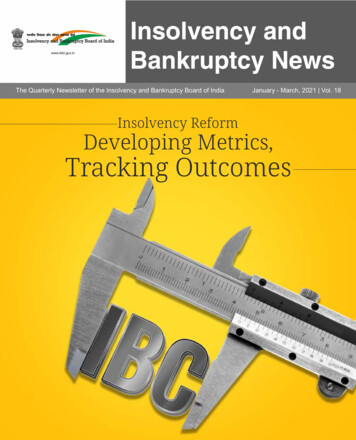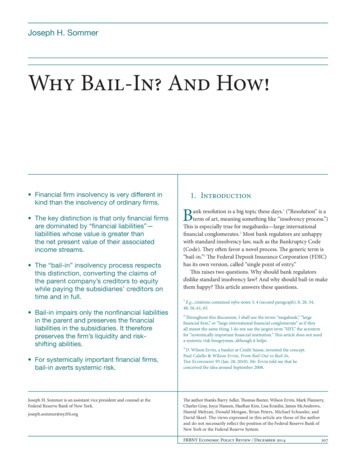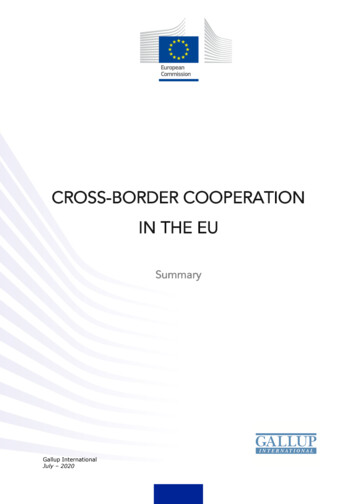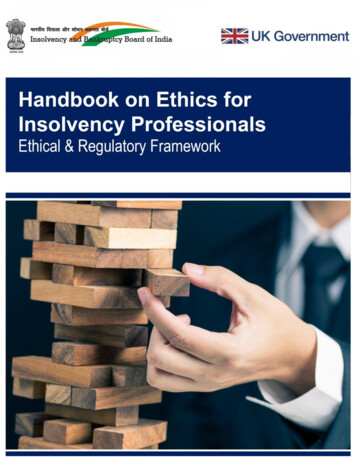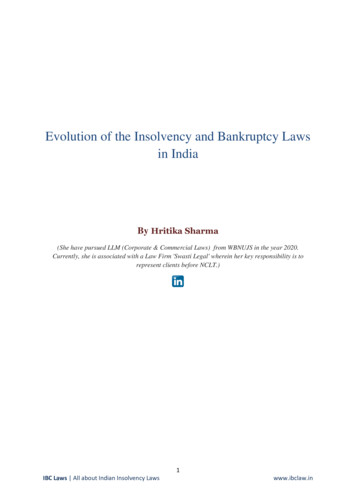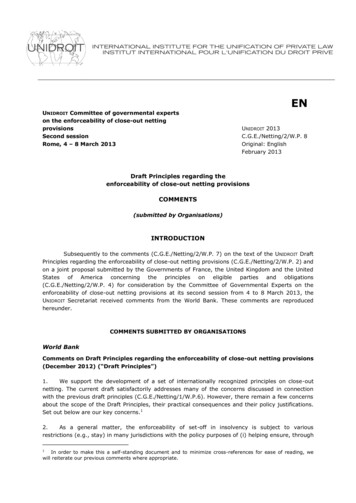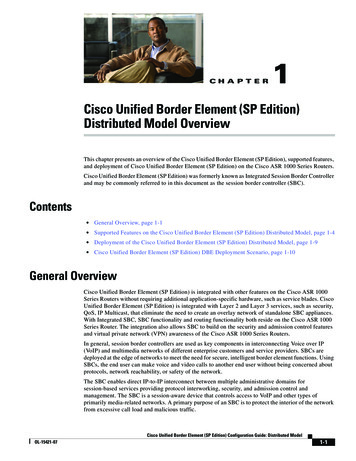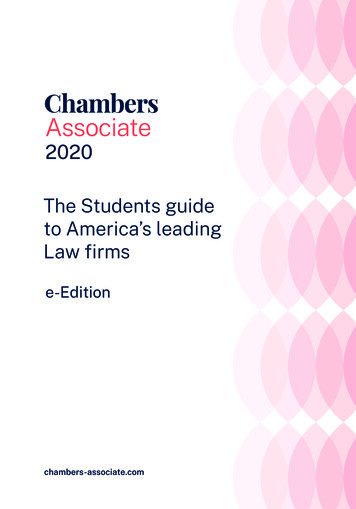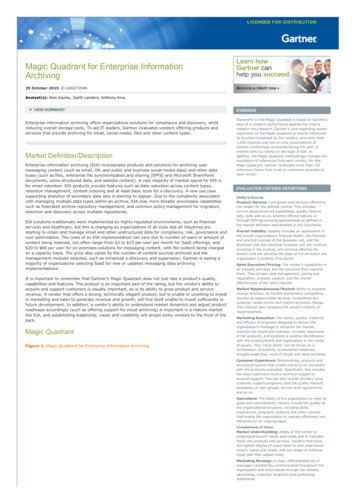
Transcription
International Corporate Rescue – Special IssueQuadrant ChambersCross-Border Insolvency andInternational Trade (Volume 3)1ForewordSimon Croall QC2Using Force Majeure Clauses in Relation to Inability to Pay: A Forlorn Hope?Simon Rainey QC5Termination Rights in the Event of Insolvency: Where Are We Now with Ipso FactoClauses; Are They Still a Potent Weapon in a Creditor’s ArmouryNigel Cooper QC9The Position of UK Directors during the COVID-19 PandemicRobert-Jan Temmink QC and Stephanie Barrett13Valuation of Services for the Purposes of Section 245 of the Insolvency Act 1986Robert-Jan Temmink QC and Victoria Kühn18Return of the MAC: The English Courts’ Approach to Material Adverse ChangeClausesJeremy Richmond QC and Liisa Lahti21Fighting Cryptocurrency Fraud: What’s in the English Lawyer’s Toolkit?Jeremy Richmond QC and Chris Recker24Green & Newman v SCL Group Ltd and others [2019] EWHC 954 (Ch): The EnglishCourt Provides Some Useful Guidance on Administrators’ DutiesJeremy Richmond QC28Winding-Up in the Post CIGA WorldNicola Allsop32The CIGA Moratorium: A Lifeline for UK Companies?Emily Saunderson35A Reach Too Far? A Review of the Extra-Territorial Scope of the Court’s Powers toSupport Office-Holder’s InvestigationsWilliam Mitchell
Editor-in-ChiefMark Fennessy, Proskauer Rose LLP, LondonPublisherSasha Radoja, Travers Smith LLP, LondonEditorial BoardEmanuella Agostinelli, Curtis, Mallet-Prevost, Colt & MosleLLP, MilanScott Atkins, Norton Rose Fulbright, SydneyJames Bennett, KPMG, LondonDan Butters, Deloitte, LondonGeoff Carton-Kelly, FRP Advisory, LondonGillian Carty, Shepherd and Wedderburn, EdinburghCharlotte Cooke, South Square, LondonKatharina Crinson, Freshfields Bruckhaus Deringer, LondonHon. Robert D. Drain, United States Bankruptcy Court,Southern District of New YorkSimon Edel, EY, LondonMatthew Kersey, Russell McVeagh, AucklandProf. Ioannis Kokkoris, Queen Mary, University of LondonProf. John Lowry, University College London, LondonNeil Lupton, Walkers, Cayman IslandsNigel Meeson QC, Conyers Dill Pearson, Hong KongMathew Newman, Ogier, GuernseyJohn O’Driscoll, Walkers, LondonKaren O’Flynn, Clayton Utz, SydneyProf. Rodrigo Olivares-Caminal, Queen Mary, Universityof LondonChristian Pilkington, White & Case LLP, LondonSusan Prevezer QC, Brick Court Chambers, LondonProf. Arad Reisberg, Brunel University, LondonJeremy Richmond QC, Quadrant Chambers, LondonDaniel Schwarzmann, PricewaterhouseCoopers, LondonThe Hon. Mr Justice Richard Snowden, Royal Courts ofJustice, LondonAnker Sørensen, De Gaulle Fleurance & Associés, ParisKathleen Stephansen, New YorkDr Artur Swierczok, CMS Hasche Sigle, FrankfurtMeiyen Tan, Oon & Bazul, SingaporeStephen Taylor, Isonomy Limited, LondonRichard Tett, Freshfields Bruckhaus Deringer, LondonThe Hon. Mr Justice William Trower QC, Royal Courts ofJustice, LondonMahesh Uttamchandani, The World Bank, Washington, DCRobert van Galen, NautaDutilh, AmsterdamMiguel Virgós, MadridL. Viswanathan, Cyril Amarchand Mangaldas, New DelhiProf. em. Bob Wessels, University of Leiden, Leiden, theNetherlandsAngus Young, Hong Kong Baptist University, Hong KongMaja Zerjal Fink, Arnold & Porter, New YorkDr Haizheng Zhang, Beijing Foreign Studies University, BeijingUS CornerEditor: Maja Zerjal Fink, Arnold & Porter, New YorkEconomists’ OutlookEditors: Prof. Ioannis Kokkoris, Queen Mary, University ofLondonKathleen Stephansen, New YorkMahesh Uttamchandani, The World Bank, Washington, DCCase Review SectionEditors: Charlotte Cooke, South Square, LondonProf. John Lowry, University College London, LondonProf. Arad Reisberg, Brunel University, LondonPublishersChase Cambria Company (Publishing) Ltd4 Winifred CloseBarnet, ArkleyHertfordshire EN5 3LRUnited KingdomAnnual SubscriptionsA hardcopy subscription is EUR 730 / USD 890 / GBP 520;online: EUR 730 / USD 890 / GBP 520; and hardcopy online:EUR 840 / USD 1045 / GBP 625. Rates per additional hardcopyor online user are: EUR 165 / USD 220 / GBP 145.VAT is charged on online and hardcopy online subscriptions.Hardcopy-only is zero-rated for VAT purposes. For packagesubscriptions, VAT is charged on the entire package.For enquiries, please contact our sales department at: 44 (0) 114 255 9040 or sales@chasecambria.comSpecial IssuesPrice for individual Special Issues for subscribers: EUR 125 /USD 175 / GBP 105; for non-subscribers: EUR 165 / USD 225 /GBP 135. Online access to all Special Issues for subscribers:EUR 375 / USD 535 / GBP 315; for non-subscribers: EUR 495 /USD 695 / GBP 420. Online subscription plus access to allSpecial Issues: EUR 995 / USD 1250 / GBP 740. Hardcopy online subscription plus access to all Special Issues: EUR 1150 /USD 1450 / GBP 875.AdvertisementsFor advertisements please contact:ads@chasecambria.comCopyrightISSN: 1572-4638 2020 Chase Cambria Company (Publishing) LtdPermissionsAll rights reserved. No part of this publication may bereproduced, stored in a retrieval system, or transmitted in anyform or by any means, mechanical, photocopying, recordingor otherwise, without prior permission of the publishers.Permission to photocopy must be obtained from the copy rightowner. Please apply to:E-mail: permissions@chasecambria.comWebsite: www.chasecambria.comDisclaimerThe information and opinions provided on the contents ofthe journal was prepared by the author/s and not necessarilyrepresent those of the members of the Editorial Board orof Chase Cambria Company (Publishing) Ltd. Any error oromission is exclusively attributable to the author/s. The contentprovided is for general purposes only and should neither beconsidered legal, financial and/or economic advice or opinionnor an offer to sell, or a solicitation of an offer to buy thesecurities or instruments mentioned or described herein. Neitherthe Editorial Board nor Chase Cambria Company (Publishing)Ltd are responsible for investment decisions made on the basis ofany such published information. The Editorial Board and ChaseCambria Company (Publishing) Ltd specifically disclaims anyliability as to information contained in the journal.
ForewordSimon Croall QC, Head of Chambers, Quadrant Chambers, London, UKWelcome to Quadrant Chambers’ third special editionof International Corporate Rescue – Cross-Border Insolvency and International Trade. In light of the ongoingbusiness uncertainty occasioned by the COVID-19pandemic it is perhaps more important than ever thatthe international trade lawyer is aware of the practical impact of cross-border insolvency on their clients’rights. To that end, the articles in this special editionaddress a wide range of topical practical issues including Material Adverse Change clauses, ContractualTermination clauses and the doctrine of frustration. Inaddition to these common law areas the special editioncontains articles addressing the impact of the Corporate Insolvency and Governance Act 2020, or CIGA,that entered into force in June 2020. CIGA represents asignificant change for international trade lawyers since(among other things) it restricts rights to terminatecontracts upon the event of counter-party insolvencyand also provides some protection from personal liability for directors of companies that may be wrongfullytrading before they enter into insolvency. The breadthand depth of the articles illustrates the broad range ofexpertise that Quadrant Chambers now boasts in thearea. Pre-COVID we had as a Chambers representedmany of the main players in the large cross-border insolvencies in recent times including OW Bunkers andHanjin Shipping. Since the pandemic we have continued that trend by advising major parties in all our mainareas of practice including international trade, energy,banking and shipping. I hope you enjoy this special edition. We, as a Chambers, look forward to assisting youin the future in this increasingly important and complex area.1
Using Force Majeure Clauses in Relation to Inability to Pay:A Forlorn Hope?Simon Rainey QC, Barrister, Quadrant Chambers, London, UKSynopsiscaused by lack of funds’ or ‘events caused by fluctuating economic conditions in local, national or globalmarkets’.Further, financing and loan agreements where thereciprocal obligations are purely financial rather thancommercial agreements, where payment is the consideration for goods or services, typically do not containany force majeure clause (as evidenced by their absencefrom the Loan Market Association precedents). Whilethere may be more sophisticated provisions which canaddress the economic effect and increased costs ofperformance and alternative means of performance,such as ‘material adverse change’ (MAC) or ‘materialadverse effect’ (MAE) clauses which allow terminationof the contract, or suspension or adjustment of contract obligations, where external events impact uponthe value of performance, even these commonly do notextend to pure market or price movements.But what of the contracts which contain a forcemajeure clause which does not exclude or restrict theavailability of the clause in relation to payment obligations? Even then it is suggested that relying on forcemajeure will in most cases be extremely difficult.The impact of coronavirus on businesses has been dramatic. Markets have vanished overnight, supply chainshave been disrupted or suspended, and many financingarrangements entered into in a different, pre-COVID19, world have become unmanageable. Worse still,many of the fixed payment obligations of the businessunder other long term contracts, such as equipmentleases or agency or franchise arrangements remain inplace and require to be met, even though turnover mayhave collapsed and payment has either become verydifficult or impossible rendering the non-paying partyvulnerable to being served with a statutory demandand being wound up on a cash flow insolvency basis.Faced with an inability to perform, many parties turnto their contracts and look for a way out, clutching atthe words ‘Force Majeure’. For the reasons explainedbelow, that is likely to be an exercise in clutching atstraws.Force majeure and payment obligationsAlmost all modern commercial contracts containa force majeure provision in one form or anotherwhich work effectively when a party is prevented bycircumstances outside its control from performing acontractual obligation. But these types of provisionpresent special difficulties where the obligation in question is an obligation to pay money due under a contract.This is because, most commonly, force majeureclauses have express provisions excluding their operation in the case of obligations to make payment of sumsdue under the contract. This can be total, e.g. ‘all eventsbeyond the control of the party which prevents orinterrupts the performance of the obligations or anyof them under this Agreement (except any obligationto make any payment hereunder)’ or ‘Force Majeureshall not include lack of available funds, financial insolvency or financial distress of the Party seeking toclaim Force Majeure’. It can also be partial, ‘Notwithstanding the foregoing, the following events shall notconstitute Force Majeure [ ] inability of a Party to payany amounts when due where such inability is solelyForce majeure clauses: the basicsA force majeure clause is a contractual term which regulates the consequences of supervening events beyondthe parties’ control on the obligations of one or bothof the parties to the contract. Such clauses typicallyrequire a causal link between such events and performance, and provide for the consequences of the eventon the parties’ obligations. The event may result in thecancellation of the contract, excuse non-performance(whether in whole or in part), or entitle a party to anextension of time and/or to suspend performance.In addition to fulfilling any procedural requirementssuch as the giving of notice, it is for the party relyingupon a force majeure clause to prove the facts bringingit within the clause. The party must prove the following, and this checklist must be applied to any COVID-19non-payment force majeure argument:1. The occurrence of an event identified in theclause;2
Using Force Majeure Clauses in Relation to Inability to Pay: A Forlorn Hope?Hamblen J stated that a seller unable to deliver theaircraft on time due to a pandemic causing a dearth ofdelivery pilots would be able to bring itself within thewording of a force majeure clause which provided ‘anyother cause beyond the seller’s reasonable control’.2. It has been prevented or hindered (as the case maybe) from performing the contract by reason of thatevent;3. That its non-performance was due to circumstances beyond its control; and4. There were no reasonable steps that could have beentaken to mitigate the event or its consequences.(3) Causation: the effect on performanceOnce a party has established the occurrence of aforce majeure event occurring beyond its control, thenext criterion is establishing that the event had and/or is having the contractually stipulated effect onperformance.Where the clause states that a party is relieved fromperformance or liability if it is ‘prevented’ from performing its obligations or is ‘unable’ to do so, it is necessaryto show physical or legal impossibility, and not merelythat performance has become more difficult or unprofitable: Tandrin Aviation Holdings Ltd v Aero Toy Store LLC(see below). Economic impossibility because the company cannot get funds at all may be difficult to show. Itwould be necessary to be able to show that the fundingcrisis of the business has been directly caused by theforce majeure event (or events), not by anything else,and to demonstrate how it is now said to be impossibleto fund the payment in question. If borrowing is possible, even on very unfavourable terms, or mortgaging orre-mortgaging the factory or premises is possible, thenit cannot be said that the performance of the paymentobligation (and one is talking about the specific payment obligation under the particular contract when itfalls due, without regard to other commitments fallingdue at other times) is not possible, when it fell due. Thegeneral economic toll of the pandemic by its variousroutes upon the business will therefore be unlikely tosuffice.The Tandrin Aviation case is a sobering reminder ofthe extreme difficulty in relying on force majeure inan economic context and in relation to payment obligations. A party sought to excuse its non-payment inpointing to its inability to get funds due to ‘the unanticipated, unforeseeable and cataclysmic downward spiralof the world’s financial markets’ (words which couldbe paraphrased for the post-COVID trading world). TheJudge (Hamblen J.) pointed out (at [40]) that it is well established under English law that a change in economic/ market circumstances, affecting the profitability of acontract or the ease with which the parties’ obligationscan be performed, is not regarded as being a force majeure event. Thus a failure of performance due to theprovision of insufficient financial resources has beenheld not to amount to force majeure – see The Concadoro[1916] AC 2 AC 199; and likewise a rise in cost or expense – see Brauer & Co. (GB) Ltd. v James Clark (BrushMaterials) Ltd. [1952] 2 All ER 497. He referred withapproval to the then edition of Chitty on Contracts (now33rd, at para. 15-163) and ‘a failure of performance(1) What is the relevant force majeure event?‘Force majeure’ is not a term of art. Whether the viraloutbreak falls within a force majeure clause will turnon the proper construction of the wording of the clause.Contractual provisions commonly enumerate forcemajeure events, which may include a ‘pandemic’ or‘epidemic’, potentially by reference to WHO classification or, more generically, ‘disease’. It is unlikely thatthe pandemic in and of itself will have had immediateramifications on contractual performance. With dailychanges in the legal and regulatory landscape as thegovernment enacts lockdown and lockdown easingmanagement measures, events of this nature or morelikely to be invoked under force majeure clauses. It is theknock-on effects which will be in issue, which gives riseto difficult questions of causation (discussed furtherbelow). It is the ripple effect of the disruption causedby the virus which will in almost all cases provide therelevant putative ‘event’. For example, the virus leadsto Government rules which restrict commercial activity altogether (by banning all non-essential shops fromopening). That ban leads to a sharp falling off in tradewhich causes a supply company to lose orders. Socialdistancing rules may prevent the supply company fromoperating at all, given its premises and numbers ofstaff, which means it can operate an online business tomitigate the effects. Lockdown is eased and restrictionseased just in time, but consumers do not then return.If financial difficulties are then encountered whichmeans that one can no longer pay one’s equipmentleasing charges, what was the relevant causativeevent? Is customer fear after the restrictions are over aforce majeure event? Did it really flow from it or is it anew cause outside the force majeure clause?(2) ‘Beyond a party’s reasonable control’Most force majeure clauses contain sweep up languagesuch as ‘any other cause beyond [the party’s] reasonable control’. The COVID-19 outbreak itself is clearlycapable of constituting such a cause. But again, is thesecondary or tertiary effect produced by it such a cause,and which is the actual trigger for inability to perform?In Tandrin Aviation Holdings Ltd v Aero Toy Store LLC[2010] 2 Lloyd’s Rep 668, which concerned a contractfor the sale of a Bombardier executive jet aircraft,3International Corporate Rescue 2020 Chase Cambria Publishing
Simon Rainey QC(5) Avoidance/mitigation: working round the problemdue to the provision of insufficient financial resourcesor to a miscalculation, a rise in cost or expense,’ wasnot capable of constituting force majeure. See alsoThames Valley Power Ltd. v Total Gas & Power Ltd. [2006]1 Lloyd’s Rep. 441.Note that some types of force majeure clause aremore generous in the sense that they do not requireoutright prevention of impossibility, but only thatthat the force majeure event should ‘hinder’ or ‘delay’performance or make it ‘unreasonably onerous’. Suchclauses may offer an easier route, but the casual connection must still be established.The existence of any steps which the non-performingparty could have taken to avoid or mitigate the effectsof a force majeure event will preclude reliance on theclause.The burden on the party claiming force majeure isin this respect a heavy one and in the context of thenon-payment of a particular debt as it falls due, particularly demanding. Can it show that there were nosteps it could have taken to pay that instalment whenit fall due, even by not paying another creditor? Or byasking the directors for a mortgage over their homes?For example, in Classic v Limbungan it was held that thenon-performing party had no means of avoiding ormitigating the dam-burst and its effect on supplies ofBrazilian iron ore, but only after an exhaustive analysis(at summary judgment: [2017] EWHC 867 (QB)) ofall possible sources of supply, including going into themarket, buying afloat and shipping back to the Brazilian ports to reship and thereby perform the COA bythis alternative route and, subsequently, a full debate inexpert evidence (at trial) as to market quantities available: see e.g. [2018] EWHC 3489 (Comm). Faced withCOVID-19 problems preventing the immediately obvious means or manner of performance of a paymentobligation, a party may be faced with a much moreexpensive and inconvenient means of performing. Ifthat is open to it, then it may later be unable to justifyits invocation of force majeure.(4) But for causation?A further question which will frequently arise is: whatif, although the pandemic or knock-on effect indisputably prevents performance of the payment obligation,the party claiming the benefit of the clause would nothave paid even absent the pandemic? Take an exampleof a counterparty already in deep financial difficultywho, before coronavirus, was suspected of being unable to perform the long-term contract or the nextobligation when it fell due. Coronavirus intervenes andprevents any performance of the contract, relieving thepressure on the counterparty, who then declares forcemajeure.This was the position in Classic Maritime v LimbunganMakmur Sdn Bhd [2019] EWCA Civ 1102 (in the author appeared). The contract was a long term contractof affreightment (‘COA’) for the carriage of Brazilianiron ore. The relevant contractual force majeure clauseexcluded liability for loss or damage ‘resulting from’ aseries of specified events, including one applicable onthe facts, which ‘directly affect the performance of either party’. The Samarco tailings dam-burst destroyedall means of the party sourcing Brazilian iron ore andprevented any possible performance of the COA. Thenon-performing party was in financial difficulties andhad missed several shipments just before the dam-burstevent as a result. It was held to be unable to rely onthis clause despite performance having been renderedwholly impossible because, but for the dam burst, onthe facts it would not have performed anyway.International Corporate Rescue 2020 Chase Cambria PublishingLooking ahead future-proofing newcontractsEven in these troubled times, trade and commerce continue. New contracts face particular challenges in thatthey are concluded against the backdrop of the pressingcurrent problems but also forecasts of continuing orextended lockdowns into the future and with the spectre of secondary outbreaks and recurrence of the virusnext winter. Special provision will need to be made incontracts attaching specifically to payment obligations,either in the form of ‘material adverse change’ (MAC)or ‘material adverse effect’ (MAE) clauses.4
Termination Rights in the Event of Insolvency: Where Are WeNow with Ipso Facto Clauses; Are They Still a Potent Weapon in aCreditor’s ArmouryNigel Cooper QC, Barrister, Quadrant Chambers, London, UKIntroductionis so often the case, the construction of the contract. Inthis regard, clauses inevitably vary in their complexity, whether it be in the definition of what constitutesa triggering event or as to the procedures, such as thegiving of notice, which have to be followed in orderfor termination to be valid. There are no special rulesof construction applicable to ipso facto clauses. Thegeneral principles laid down in cases such as Arnold vBritton [2015] AC 1619 and Wood v Capita [2017] AC1173 apply. In summary, one is looking to ascertainthe objective meaning of the language used by the parties to express their agreement. This means looking atthe contract as a whole and, depending on the nature,formality and quality of the drafting, giving more orless weight to the wider context of the agreement.However, the consequences of triggering an ipso factoprovision are inevitably severe. In addition, the courtshave emphasised in a series of recent judgments thatthe principles which apply to the construction of exclusion clauses and indemnity provisions do not represent special rules applicable only to certain types ofclauses but represent principles of construction whichare to be used alongside the general principles of construction for the purposes of determining the intention of the parties; cf. Fujitsu Services Ltd. v IBM UnitedKingdom Ltd [2014] EWHC 752 (TCC) at [24] – [26]and CNM Estates v VeCref I Sarl [2020] EWHC 1605(Comm) at [14] – [18]. As such, when questions ariseas to the construction of an ipso facto clause, a courtshould be guided by the principle that clear words arenecessary to define the circumstances in which theparties intended that the right of termination wouldaccrue.The first question with any ipso facto clause iswhether there has been a triggering event, whichgives rise to the right to terminate. Clauses may define when a party is deemed to be insolvent by reference to specific insolvency events and may include aproviso that insolvency events include any similar orequivalent event under any applicable law. But even inthe absence of such proviso, the question arises as towhich law determines the nature of the event said toconstitute insolvency.Long term contracts frequently contain clauses whicheither terminate the contract automatically or entitlea party to terminate the contract in the event of theother party becoming insolvent; so-called ‘ipso facto’clauses. The use of such clauses is controversial andin many jurisdictions such clauses are unenforceablebecause they are seen as allowing one creditor to takepriority over other creditors in relation to property thatshould otherwise form part of the bankruptcy estate.English law did not share this approach but viewed theoperation of such clauses as being essentially a matterof contractual construction. That position has nowchanged with the coming into force of amendments tothe Insolvency Act 1986 (‘IA 1986’) introduced by theCorporate Insolvency & Governance Act 2020 (‘CIGA2020’), which make ipso facto clauses in contracts forthe supply of goods and services unenforceable againstan insolvent party. The purpose of this article is to examine some of the issues which arise in relation to theconstruction of ipso facto clauses and to explain the effect of the amendments to the IA 1986.Ipso facto clauses are generally considered validunder English law. They do not, without more, offendagainst the public policy that prevents a party contracting out of the pari passu distribution of an insolvent’sassets. Nor do they offend against the anti-deprivationrule, which prevents a party from withdrawing assetson bankruptcy, liquidation or administration so as toreduce the value of the insolvent estate to the detrimentof creditors. As to the last, the Supreme Court held inBelmont Park Investments Pty Ltd v BNY Corporate Trustee Services Ltd [2012] 1 AC 383 that the rule would notinvalidate clauses which did not amount to an illegitimate intent to evade bankruptcy or insolvency law andhad a legitimate commercial basis.Construction of the contractThe starting point for considering the applicability andeffectiveness of an ipso facto clause will therefore be, as5
Nigel Cooper QCConflicts of lawof the contractual provisions. So, for example, anynotice of termination needs to be in sufficiently clearterms to communicate the decision to terminate; seeNewland Shipping & Forwarding Ltd v Toba Trading FZC[2014] EWHC 661 (Comm). The contrast is unilateralcontracts, such as options, where strict compliancewith the express requirements of any terminationclause will be required; see Siemens Hearing InstrumentsLtd v Friends Life Ltd [2014] EWCA Civ 382.If the conditions for termination are met, can the exercise of a termination clause be prevented? On the faceof it, if the requirements of the termination clause havebeen met, then should be enough to bring the contractto an end. But what if the party alleged to be insolventclaims that it is only in such a situation because ofthe actions of the terminating party or that the terminating party has engineered a situation, which hasallowed insolvency proceedings to be commenced notwithstanding that there is no genuine insolvency.English law does not (at least at present) recognisea general duty of good faith but there are a number ofpossible principles, which may assist the party allegedto be insolvent.One line of argument, which has been put forwardin connection with other forms of termination clausesis that there is an implied term that the right of termination should not be exercised in an arbitrary, capricious or unreasonable way adopting the reasoning inBraganza v BP Shipping Ltd [2015] 1 WLR 1661. However, a series of cases has found that where one party isgiven an unqualified right of termination, there is noplace to imply a term along Braganza lines; see TAQABratani Ltd v Rockrose [2020] EWHC 58 (Comm), Monkv Largo [2016] EWHC 1837 and Cathay Pacific AirwaysLtd v Lufthansa Technik AG [2020] EWHC 1789 (Ch).While arguments based on good faith are unlikelyto succeed, there are alternatives that given the rightcombination of facts may succeed. First simply as amatter of construction, it may be possible to arguethat notwithstanding the existence of an insolvencyproceeding, there is no genuine insolvency and on theproper construction of the relevant clause there aretherefore no sufficient proceedings to trigger a rightto terminate. Alternatively, if the events said to triggerthe operation of the termination clause have arisen because of interference by the party relying on the clausein the performance of the contract, it may be possible tomake good an argument that there has been a breachof one or more of the following implied terms: an implied term that both parties will perform the contracthonestly; an implied term that neither party will frustrate the purpose of the contract or an implied termthat both parties would cooperate in the performanceof the contract and would not seek to prevent theother party’s performance of the contract. Whethersuch terms will be implied depends of course on matters such as whether such terms would be consistentwith the express terms of the contract and whether orIf the relevant insolvency proceedings take place in thesame jurisdiction as the applicable law of the contract,there is no difficulty in answering the question, it is theapplicable law of the contract. But in many contractssubject to English law, it is equally possible that the relevant insolvency proceedings will take place in anotherjurisdiction. Is it still then only the governing law of thecontract which determines the nature of the proceedings or should one also look to the law of the countrywhere the event in question is taking place?The better view must be that the construction ofthe contract is a matter for English law and, therefore,whether or not the attribut
online: EUR 730 / USD 890 / GBP 520; and hardcopy online: EUR 840 / USD 1045 / GBP 625. Rates per additional hardcopy or online user are: EUR 165 / USD 220 / GBP 145. VAT is charged on online and hardcopy online subscriptions. Hardcopy-only is zero-rated for VAT purposes. For package subscriptions, VAT is charged on the entire package.
